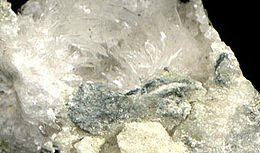
Back سترونتيانيت Arabic Странцыяніт BE Estroncianita Catalan Stroncianit Czech Strontianit German Estroncianita Spanish Estrontzianita EU استرونتیانیت FA Strontianiitti Finnish Strontianite French
| Strontianite | |
|---|---|
 Strontianite from Slovakia | |
| General | |
| Category | Carbonate minerals |
| Formula (repeating unit) | SrCO3 |
| IMA symbol | Str[1] |
| Strunz classification | 5.AB.15 (10 ed) 5/B.04-20 (8 ed) |
| Dana classification | 14.01.03.03 |
| Crystal system | Orthorhombic |
| Crystal class | Dipyramidal (mmm) H-M symbol: (2/m 2/m 2/m) |
| Space group | Pmcn |
| Unit cell | a = 5.1 Å, b = 8.4 Å c = 6.0 Å; Z = 4 |
| Identification | |
| Formula mass | 147.63 g/mol |
| Color | Colourless, white, gray, light yellow, green or brown; colourless in transmitted light |
| Crystal habit | Prismatic, acicular, pseudo hexagonal, columnar to fibrous, granular, massive |
| Twinning | Very common, usually contact, rarely penetration, also repeated |
| Cleavage | {110} nearly perfect, {021} poor, {010} traces |
| Fracture | Subconchoidal to uneven |
| Tenacity | Brittle |
| Mohs scale hardness | 3+1⁄2 |
| Lustre | Vitreous, resinous on breaks, greasy |
| Streak | White |
| Diaphaneity | Transparent to translucent |
| Specific gravity | 3.74 to 3.78 Transparent versions are heavier than the other ones |
| Optical properties | Biaxial (−) |
| Refractive index | nα = 1.52, nβ = 1.66, nγ = 1.67 |
| Birefringence | 0.15 |
| 2V angle | Measured: 7°, Calculated: 12° to 8° |
| Ultraviolet fluorescence | Almost always fluorescent |
| Solubility | Soluble in dilute HCl |
| Alters to | Celestine SrSO4 |
| References | [2][3][4][5] |
Strontianite (SrCO3) is an important raw material for the extraction of strontium. It is a rare carbonate mineral and one of only a few strontium minerals. It is a member of the aragonite group.
Aragonite group members:[2] aragonite (CaCO3), witherite (BaCO3), strontianite (SrCO3), cerussite (PbCO3)
The ideal formula of strontianite is SrCO3, with molar mass 147.63 g,[4] but calcium (Ca) can substitute for up to 27% of the strontium (Sr) cations, and barium (Ba) up to 3.3%.[2]
The mineral was named in 1791 for the locality, Strontian, Argyllshire, Scotland, where the element strontium had been discovered the previous year.[2] Although good mineral specimens of strontianite are rare, strontium is a fairly common element, with abundance in the Earth's crust of 370 parts per million by weight, 87 parts per million by moles, much more common than copper with only 60 parts per million by weight, 19 by moles.[6] Strontium is never found free in nature. The principal strontium ores are celestine SrSO4 and strontianite SrCO3. The main commercial process for strontium metal production is reduction of strontium oxide with aluminium.[6]
- ^ Warr, L.N. (2021). "IMA–CNMNC approved mineral symbols". Mineralogical Magazine. 85 (3): 291–320. Bibcode:2021MinM...85..291W. doi:10.1180/mgm.2021.43. S2CID 235729616.
- ^ a b c d Gaines et al (1997) Dana’s New Mineralogy Eighth Edition. Wiley
- ^ Strontianite on Mindat.org retrieved 23/08/11
- ^ a b Barthelmy, Dave. "Strontianite Mineral Data". Retrieved 23 August 2011.
- ^ "Strontianite in the Handbook of Mineralogy" (PDF). Retrieved 24 August 2011.
- ^ a b "Strontium". Retrieved 24 August 2011.